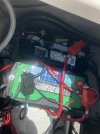Hello guys, was recently out on the water in my family’s 2021 251 ce when it randomly stopped dead in the water. We were traveling at about 23 knots and the whole system turned off. The boat came halting to a stop with our Simrads turning off and engine turning off. The system came back up with low voltage alarm. We tried starting back up and the engine made clicking noises and didn’t start. I turned the power completely off and then sitting for a minute we cranked back up on battery 2 and the boat acted like nothing was wrong (we were running in dual battery mode previously). All systems worked seemingly fine after. My first instinct was to check the kill switch and it had not been pulled. It seemed a little loose but the switch had not been able to recess in. The next day battery one is on 9 volts and won’t crank. Battery 2 works fine again and we leave and cruise with no issues.
Background on why we were running in dual battery mode: From day one battery one has had issues, we took it into the dealer and they replaced the battery. Later we had the same issue again and they said that the radio was pulling down the battery overnight. At the same time we installed a battery charger for the house batteries to plug in at the dock. The mechanic recommended that we run the boat in dual battery mode to charge them both so we have. I am aware Grady doesn’t recommend this but hell the dealer said to. The boat has been in times for this same issue. Does anyone have any ideas on what could be going on?
Background on why we were running in dual battery mode: From day one battery one has had issues, we took it into the dealer and they replaced the battery. Later we had the same issue again and they said that the radio was pulling down the battery overnight. At the same time we installed a battery charger for the house batteries to plug in at the dock. The mechanic recommended that we run the boat in dual battery mode to charge them both so we have. I am aware Grady doesn’t recommend this but hell the dealer said to. The boat has been in times for this same issue. Does anyone have any ideas on what could be going on?


